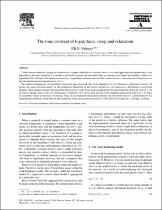JavaScript is disabled for your browser. Some features of this site may not work without it.
- ResearchSpace
- →
- Research Publications/Outputs
- →
- Journal Articles
- →
- View Item
| dc.contributor.author |
Nabarro, FRN

|
en_US |
| dc.date.accessioned | 2007-03-26T11:38:38Z | en_US |
| dc.date.accessioned | 2007-06-07T10:07:56Z | |
| dc.date.available | 2007-03-26T11:38:38Z | en_US |
| dc.date.available | 2007-06-07T10:07:56Z | |
| dc.date.issued | 2001-07-15 | en_US |
| dc.identifier.citation | Nabarro, FRN. 2001. Time constant of logarithmic creep and relaxation. Materials Science and Engineering A, vol. 309, pp 227-228 | en_US |
| dc.identifier.issn | 0921-5093 | en_US |
| dc.identifier.uri | http://hdl.handle.net/10204/2054 | en_US |
| dc.identifier.uri | http://hdl.handle.net/10204/2054 | |
| dc.description.abstract | Under certain conditions, the plastic extension of a sample subjected to a constant stress is to a good approximation proportional to the logarithm of the time. Similarly, if a sample is plastically strained and unloaded, there are changes in its length and hardness which vary logarithmically with time. For dimensional reasons, a logarithmic variation must involve a time constant tau characteristic of the process, so that the deformation is proportional to ln(t/tau). Two distinct mechanisms of logarithmic creep have been proposed, the work-hardening of a set of barriers to dislocation motion, all having the same activation energy, or the progressive exhaustion of the weaker barriers in a set which has a distribution of activation energies, these energies remain constant during the process of creep. It has been suggested that the experimentally observed value of tau can be used to decide which of the two mechanisms is operative. It is shown here that the work-hardening mechanism expresses tau in terms of parameters which are not easy to estimate, while, if the exhaustion mechanism operates, the observed value of tau is determined by the experimental conditions rather than by the parameters of the dislocation mechanism. | en_US |
| dc.format.extent | 55235 bytes | en_US |
| dc.format.mimetype | application/pdf | en_US |
| dc.language.iso | en | en_US |
| dc.publisher | Elsevier Science SA | en_US |
| dc.rights | Copyright: 2001 Elsevier Science SA | en_US |
| dc.subject | Logarithmic creep | en_US |
| dc.subject | Exhaustion mechanism | en_US |
| dc.subject | Dislocation mechanism | en_US |
| dc.subject | Work hardening | en_US |
| dc.subject | Materials sciences | en_US |
| dc.subject | Multidisciplinary | en_US |
| dc.title | Time constant of logarithmic creep and relaxation | en_US |
| dc.type | Article | en_US |
| dc.identifier.apacitation | Nabarro, F. (2001). Time constant of logarithmic creep and relaxation. http://hdl.handle.net/10204/2054 | en_ZA |
| dc.identifier.chicagocitation | Nabarro, FRN "Time constant of logarithmic creep and relaxation." (2001) http://hdl.handle.net/10204/2054 | en_ZA |
| dc.identifier.vancouvercitation | Nabarro F. Time constant of logarithmic creep and relaxation. 2001; http://hdl.handle.net/10204/2054. | en_ZA |
| dc.identifier.ris | TY - Article AU - Nabarro, FRN AB - Under certain conditions, the plastic extension of a sample subjected to a constant stress is to a good approximation proportional to the logarithm of the time. Similarly, if a sample is plastically strained and unloaded, there are changes in its length and hardness which vary logarithmically with time. For dimensional reasons, a logarithmic variation must involve a time constant tau characteristic of the process, so that the deformation is proportional to ln(t/tau). Two distinct mechanisms of logarithmic creep have been proposed, the work-hardening of a set of barriers to dislocation motion, all having the same activation energy, or the progressive exhaustion of the weaker barriers in a set which has a distribution of activation energies, these energies remain constant during the process of creep. It has been suggested that the experimentally observed value of tau can be used to decide which of the two mechanisms is operative. It is shown here that the work-hardening mechanism expresses tau in terms of parameters which are not easy to estimate, while, if the exhaustion mechanism operates, the observed value of tau is determined by the experimental conditions rather than by the parameters of the dislocation mechanism. DA - 2001-07-15 DB - ResearchSpace DP - CSIR KW - Logarithmic creep KW - Exhaustion mechanism KW - Dislocation mechanism KW - Work hardening KW - Materials sciences KW - Multidisciplinary LK - https://researchspace.csir.co.za PY - 2001 SM - 0921-5093 T1 - Time constant of logarithmic creep and relaxation TI - Time constant of logarithmic creep and relaxation UR - http://hdl.handle.net/10204/2054 ER - | en_ZA |






